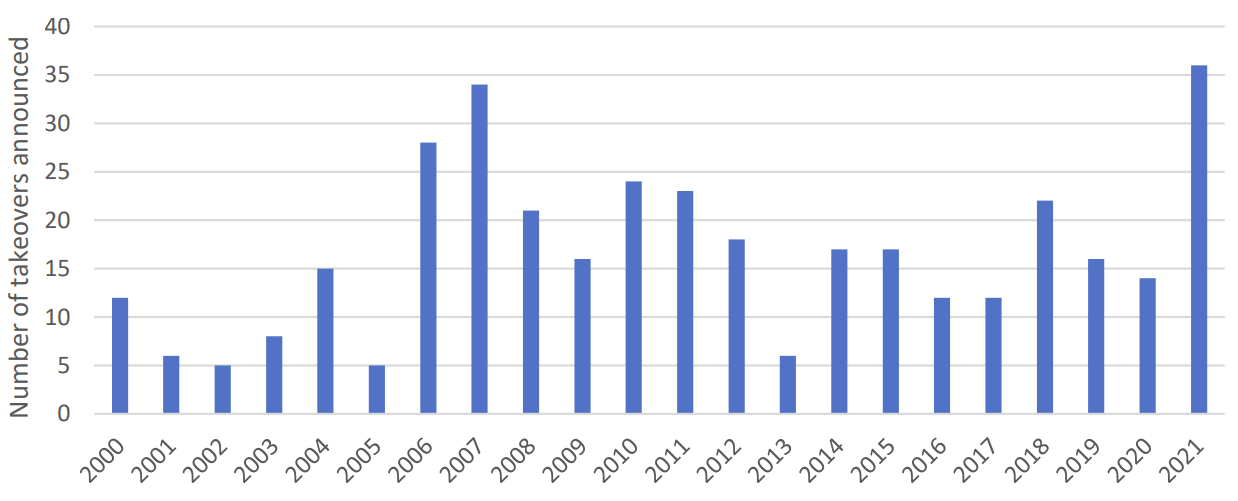Overcoming uncertainty with takeover statistics
2021 was a hot year for M&A activity as markets continued their COVID recovery and access to debt and equity capital increased. According to data from UBS, the number of takeovers announced where the target’s EV was greater than USD 250m, eclipsed the 2007 record.

Typically, shareholders of the target company enjoy a takeover premium in the order of 30% but proposed takeovers can fall through, and target companies tend to trade at a discount to the takeover price until the takeover completes, sometimes several months after the initial announcement. This uncertainty creates a conundrum for portfolio managers as to whether to hold a position in a target during the takeover period or not.
So we set out to answer: 1) what percentage of proposed takeovers succeed? and 2) are there any common characteristics that mean a takeover is more or less likely to succeed?

The figure above shows takeover success rates for different groups of takeover attempts in the ASX 300, using data from Bloomberg since the late 90s. Perhaps most surprising, is that only 62% of takeovers have been successfully completed. Since 2010, the success rate has been even lower at 56%. The data also shows that takeovers of smaller companies have been more likely to succeed and that takeovers by an offshore acquirer have been less likely to succeed, possibly due to regulatory hurdles.

The next figure above shows the sector with the highest takeover success rate has been Communication Services, where takeovers have succeeded 75% of the time. The sector with the lowest takeover success rate has been Consumer Staples, where takeovers have succeeded only 20% of the time.
Bringing it all together
The key takeaway is that a position in the target could be reduced in the period after the takeover announcement, depending on the share price relative to the takeover price and the nature of takeover. Holding a larger position in the target makes more sense when the target is small, the acquirer is not based offshore and the target is in the Communication Services, or to a lesser extent the Industrials or Materials sectors. Takeovers where the targets are in the Consumer Staples and Health Care sectors have had lower success rates.
Outlook
It seems that 2022 is already presenting more than the usual number of variables for investors to weigh and position for. Financial markets will adapt to the progressive removal of liquidity either via the Feds quantitative tightening or the reality that recovering real economies naturally absorb excess liquidity, previously diverted to risk assets. Participants should ready for a dial up in asset volatility in 2022.
Markets are now well into the teeth of the Fed pivot with an imminent cessation of bond purchases and the commencement of a hiking campaign, possibly as soon as March. There remains the risk that the Feds inflation containment actions are too slow with a campaign for more and quicker hikes than equity investors will be prepared to entertain. Under ‘normal’ circumstances stock markets perform well during tightening regimes but these are far from normal times.
“In economics, things take longer to happen than you think and then they happen faster than you thought they could” - Rudiger Dornbusch
James Bullard, President of the Fed Reserve Bank of St Louis, in recent days upped his call for 4 hikes from 3 for 2022. Even with rising disquiet around rates it is heartening that current equity risk premiums for both US and Australian stock markets continue to offer a nice buffer to equities positions in preference to bonds.
Eley Griffiths Group remain in the camp that the yield curve ‘bear steepener’ playing out currently, supporting cyclical and resource names, will persist through the June quarter. Thenceforth, a yield curve ‘bear flattener’ will ensue in accord with reduced inflationary expectations, a levelling off in earnings and a flight to structural growth/quality stocks.
The wildcard for US corporate earnings is how lasting and damaging global supply chain disruptions and labour market distortions will be on toplines and operating margins as an outworking of the omicron variant. The imminent US Q4 reporting season will see decelerated earnings growth when compared to Q1-Q3 and ideally confirm that the markets 2022 consensus earnings growth rate of 10% is broadly attainable.
Locally, the Australian market will remain captive to offshore bond market machinations as well as our own omicron impacts with concomitant supply chain upheaval and current consumer withdrawal. Throw in a pending Federal election to keep things interesting.
With this many variables plus a US mid-term election cycle in play, short term investor sentiment will remain fragile. It
remains to be seen whether the reflexivity of earnings growth -> investor confidence/equity fund inflow -> higher share
prices can persevere in 2022.
This wire is an extract from the December edition of our quarterly newsletter, The Encyclical.
Access Australia's most compelling companies
Eley Griffiths Group is a specialist at focusing on small and emerging companies in Australia. Find out more by visiting the fund profile below.

1 fund mentioned

